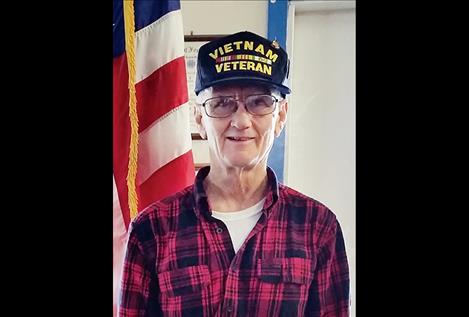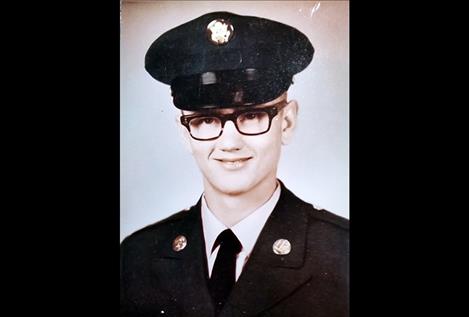Veteran Spotlight
Charles R. Larum October 21, 1946 Vietnam U.S. Army Chemical Corps and Inventory Specialist – SPC 4
Hey savvy news reader! Thanks for choosing local.
You are now reading
2 of 3 free articles.
Chuck Larum was farming with his family in Charlo when he got a surprise – his draft notice. Some guys got deferments for being an only son or were 4F with physical problems, but Chuck was unlucky enough to be 1A. February 16, 1967, found him on his way by bus to Butte, Montana, for induction into the armed forces. He wondered, “What did I get myself into?”
After eight weeks of basic training from Feb. 23-April 27 at Fort Leonard Wood, Missouri, Chuck graduated and was promoted from E-1 to E-2. With no leave time he went on to Fort McClellan, Alabama, for AIT (advanced individual training) with the Chemical Corps 54A10. He learned how to take care of those exposed to nerve gas or chemical blister agents. He said Agent Orange wasn’t talked about yet in 1967.
At the end of June, now a PFC (Private First Class), Chuck finally got a leave and went home until he had to report July 5, 1967, to Fort Lewis, Washington. He spent five long months there until Dec. 14 when he got orders for the 239th Field Service Company in Vietnam.
After going home again on a 30-day leave he left Missoula on Jan. 20, 1968, for San Francisco and then to Oakland Army Base, California. After about a 12-hour flight he landed at Long Binh near Saigon, Vietnam, as part of the 22nd Replacement Battalion. He was there one day and then got another surprise – his orders were changed to Cam Ranh Bay, Vietnam, which was a major supply base for the central part of South Vietnam. Chuck’s MOS (military occupational specialty) was the 76th P20, and he was assigned to the Headquarters Company, 96th Supply and Service as an Inventory Specialist. This was a good change because he could have been assigned to infantry or whatever.
Chuck started on days but then switched to nights, which he liked better. His job was to look up codes for supply items being requested like clothes, food, rifles, ammunition, knives, etc. and enter them on the request forms. Guys then took the forms to the warehouse to get the items. Chuck didn’t mind the job but there was too much paperwork and red tape.
He was really on alert all the time with M-14 rifle ready, especially the 24-hour alert during the famous 1968 Viet Cong TET offensive. His area wasn’t hit but many others suffered severe losses. He pulled KP (kitchen patrol) twice based on when his name came up on the alphabetical roster. KP days were long – from 4 a.m. – 9 p.m. With each KP he missed an obstacle test, such as crawling under barbed wire under live fire. That sounds like good luck.
For entertainment there were weekend parties, volleyball in the evenings and after work, and swimming in Cam Ranh Bay - but you better not have any scratches because the salt water would really hurt. The highlight of entertainment was the annual USO show with Bob Hope. There was always quite a bunch of girls – Connie Stevens, Elaine Dunn, Raquel Welch, etc. In 1971, astronaut Neal Armstrong, famous for his walk on the moon, was there. One time a band from Australia played at the EM Club (Enlisted Men’s Club) and Chuck decided to spend his R&R (rest and relaxation) in Sydney, Australia, which involved crossing the International Date Line.
There was one more surprise waiting for Chuck – a very good one. He was part of a group sent back early. On Jan. 16, 1969, he had another 12-hour flight from Cam Ranh to McCord AFB (Air Force Base) outside of Tacoma, Washington. From there he was bused to Fort Lewis, Washington. His service time was 30 days short of two years, and since he had five months or less left to serve, he qualified for an early out. Originally Chuck had signed up for a six-year deal: two years active duty, two years inactive, and two years in the Reserves; however, he was never asked to put in the last four years - he was just done.
Chuck says, “I made it through a bad situation but I’m proud to have served my country.” He never really thought about staying in because he was ready to come home and move on to something else. There were anti-war protests and demonstrations on the east coast, but not around here. Mostly he went back to working on ranches and tried to forget. Chuck doesn’t know where any of his unit is today, but one guy from another unit used to send Christmas cards from Virginia. Chuck’s last card to him came back and he doesn’t know what happened.
The ceasefire in Vietnam was in 1973, four years after Chuck got out. He says it was all a long time ago, but if he looks back, it seems like yesterday. Serving in the military can be a good thing. A person learns a lot, meets people, travels around, has opportunity to learn a trade – and there is 20-year retirement if you stay in.
Thank you for your service, Chuck.

















